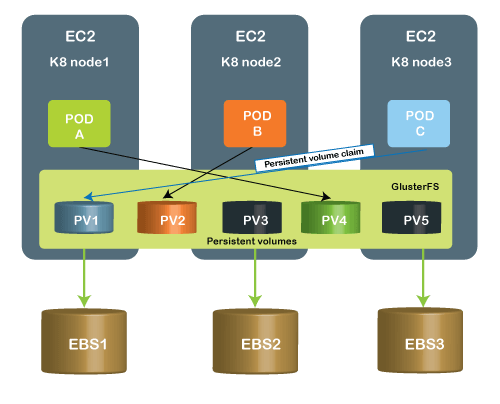Persistent Storage
Persistent storage is any device for data storage that preserves data after turning off power to that device. Often, it is also referred to as non-volatile material. As with the different optical media formats such as DVDs, magnetic media such as hard disc drives and tape are typical types of permanent storage. Persistent storage structures can be in the form of storage for files, blocks or objects. For the most part, the simplest prerequisite of any storage system is that storage longevity is a guarantee, whether it applies to a single disc, a shared networked storage system or a cloud storage facility. Unusually, it is even listed in the technological requirements for storage devices and systems, so persistence is believed.
Persistent solid-state storage
Examples of permanent storage are also solid-state drives. Still, they vary from the other types of persistent media in that they contain no moving components, either internally or for the drives necessary to access the media.

Few types of solid-state storage, especially the chips used for RAM and cache devices, are typically non-persistent storage devices, meaning that the information they bear is deleted when continuous power ceases to flow through the computers. However, some types, such as non-volatile RAM and flash-based RAM, are persistent; when the primary energy source is cut off, they usually rely on battery power. A degree of persistence can also be obtained using supercapacitors that hold an electrical charge rather than a battery buffer. RAM retains active work that may not have been saved to a disc drive or solid-state drive yet in the event of a crash or rebuild. RAM persistence may avoid data loss.
One drawback to volatile or non-persistent storage resources is that they destroy all their data when power is turned off. Relative to persistent storage equipment, they usually offer less security risk.
Persistent storage and containerization
However, there is one exception associated with recent developments in virtualized computing that has helped increase storage persistence as a problem. In recent years, containerization has become a common way to package software and their operating systems into isolated, transportable modules that are generated and destroyed as much as possible. But containers did not originally allow permanent storage, which means that the data generated by a containerized app would disappear until the app completed its function, and the container was broken.
However, some software and storage vendors have recently developed methods to retain the data generated by container applications and keep them in familiar storage volumes. Storage volumes are generally associated with state-of-the-art applications, such as databases, which remain accessible even if the application is shut down or processed. These advances in storage containers solve the problem of retaining the more ephemeral storage volumes that live and die with the stateless apps run from containers.
Types of persistent storage
- Kubernetes: OpenShift is a platform-as-a-framework service designed on the packaging of Docker containers that uses Kubernetes to orchestrate containerized software clusters around a cluster. Before a program could consume them, storage volumes had to be pre-provisioned and manually registered as Persistent Volume objects. Storage Class objects allow a provisioner interface that generates storage volumes for on-demand applications.
- Containers: OpenStack swift is a fully distributed storage solution that can be used for storing any form of static data or binary objects, such as media files, massive datasets, and disc images. By using bins, the solution organizes these objects. Although instances can only access a volume’s contents, the objects within a container can be accessed by the REST API of object storage. Thus, almost any service in a public or private cloud will use object storage as a repository.
Persistent storage (PV) use cases
Certain functions produce information that must be preserved. A sales tax calculating feature, for instance, produces information that needs to be stored and exchanged within an application. In the following approaches, essential data that must remain may be handled.
Migrating traditional applications into the cloud: By switching to a transparent and more extensible infrastructure in the cloud, the ‘lift-and-shift’ approach opens pathways to IT modernization. For sound market purposes, businesses employ lift and change, including lowered costs and increased efficiency and resilience.
Continuous integration and continuous delivery: Continuous integration and continuous distribution are two software development techniques intended to increase programming consistency and accelerate code delivery and implementation. To ensure fast implementation of new product functionality and updates, they are typically implemented together.
Data infrastructure management: Automation of data infrastructures requires agility to keep pace as IT environments grow and evolve rapidly. Via multi-cloud, DevOps, and virtualization environments, this versatility can be achieved.
How does persistent storage work with containers?
- Persistent Volume: PVs are cluster services with a lifecycle independent of any particular pod that uses a PV. On the host computer, this is the “physical” volume that holds permanent data. Persistent Volumes have cluster storage services, allowing the storage resource to survive even though it is cycled by the pods that use them. Persistent Volumes can be provisioned statically or dynamically, and by specifying properties such as efficiency, scale, and access mode, they can be configured for usage.
- Trident: Trident interfaces with the Kubernetes Persistent Volume platform and offers NetApp ONTAP and SolidFire scale-out storage networks with a single interface for storage provisioning. It is deployed as a highly usable “deployment” of Kubernetes and interacts with the API server in the form of Persistent Volume Claims to process pod storage requests.
- Persistent Volume Claim: PVCs are resource requests that serve as resource claim tests. A PVC is a request to build a Persistent Volume for the network and connect PVs via a PVC to pods.
